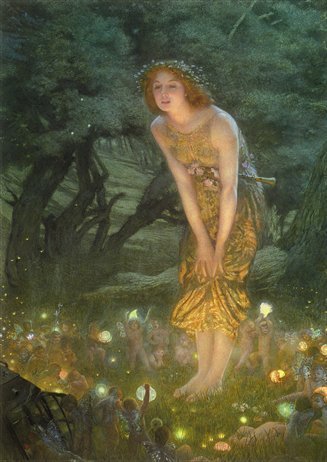
Edward Robert Hughes, Midsummer Eve.
Watercolour and gouache on paper mounted
on cardboard, 114.4 x 76.2 cm.
Private Collection.
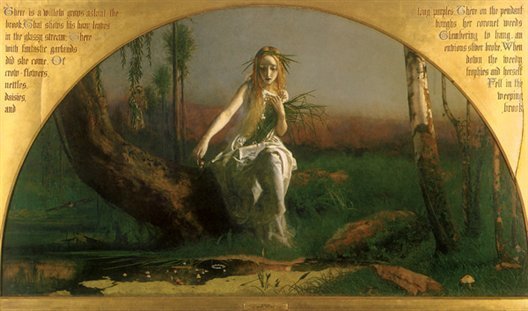
Arthur Hughes, Ophelia, 1852.
Oil on canvas, 68.7 x 123.8 cm.
Manchester Art Gallery, Manchester.
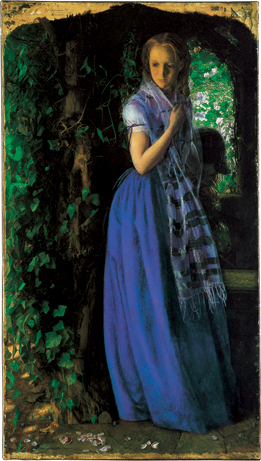
Arthur Hughes, April Love, 1855-1856.
Oil on canvas, 89.9 x 49.5 cm.
Tate Gallery, London.
It has others to offer, numerous and useful, about the phenomena of nature, the events of history and the meaning of life. “All great art is to some degree didactic,” said Ruskin, “the principal goal of popular art should be didactic.” Here we have the explanation, and to a certain degree the excuse, for the minute details and prodigious accessories that encumber most English paintings to the detriment of the whole. They are intended to teach the onlooker. It is not out of conceit over his ability, dexterity and virtuosity that the English painter studies every detail of a flower or a rock; it is so that a dicotyledone is not confused with a monocotyledone, or a granitic terrain with a schistose terrain. Remember that one of the first P.R.B., Collins, included an Alisma plantage in one of his paintings and thereby won over the botanists. Mr. Chesneau told the story of a scholar, surprised to find one of Hunt’s paintings (The Hireling Shepherd) in a zoological museum. He was moved to recognise an admirable depiction of a death’s head sphinx moth in the foreground, as well as a Geranium roberlianum and other plants painted with so much scientific precision that this work could have been used in a natural history lesson.[37] “Thus,” said Ruskin, “it is not at all a question of taste whether one prefers a finished painting or an unfinished one. It is simply a question of whether one wants to see truth or falsehood, and those who are inclined to prefer darkness to light or illusion to fact would do better to devote themselves to anything but art.” He did not hesitate to declare that the primary goal of the painter should be to scientifically teach the laws of the universe and the facts of history. He thought badly of a painting that teaches us nothing about the geological composition of the landscape, or the families of plants that grow in it, or the architectural ruins that lie in it: “Nor do I myself see,” he said, “wherein the great difference lies between a master and a novice, except in the rendering of the finer truths of which I am at present speaking. To handle the brush freely, and to paint grass and weeds with accuracy enough to satisfy the eye, are accomplishments that a year or two’s practice will give any man: but to trace among the grass and weeds those mysteries of invention and combination by which nature appeals to the intellect; to render the delicate fissure, and descending curve, and undulating shadow of the mouldering soil, with gentle and fine finger, like the touch of the rain itself; to find even in all that appears most trifling or contemptible, fresh evidence of the working of the Divine power ‘for glory and for beauty,’ and to teach it and proclaim it to the unthinking and the unregarding: this, as it is the peculiar province and faculty of the master-mind, so it is the peculiar duty which is demanded of it by the Deity.”[38]
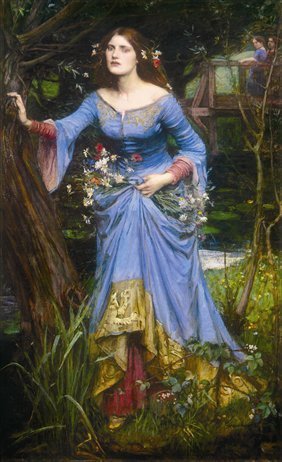
John William Waterhouse,
Ophelia, undated.
Oil on canvas, 102 x 64 cm.
The Pre-Raphaelite Trust.
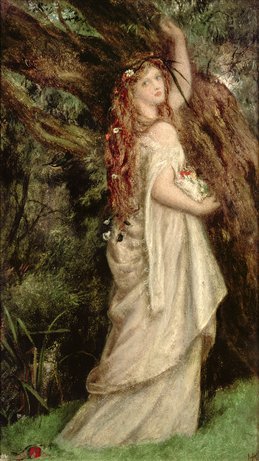
Arthur Hughes, Ophelia, 1871.
Oil on panel, 33.3 x 21.1 cm.
The Ashmolean Museum of Art and Archaeology,
University of Oxford, Oxford.
This last point reveals the depths of English thought. Art should be didactic, but this is not an end in itself. It is because by using the minute to show us how admirable creation is, it inspires us to praise our Creator. Ruskin, already an old man, wrote on September 16th, 1888, in Chamonix: “All that is involved in these passionate utterances of my youth was first expanded and then concentrated into the aphorism given twenty years afterwards in my inaugural Oxford lectures: All great Art is Praise.” Watts, criticising Haydon, states that “All art that has had real and lasting success has popularised some great principle of mind or matter, some great truth, or some great paragraph in the book of nature.” Hunt clarifies this goal by saying: “I believe that any enlightened person who goes into a museum and familiarises himself with all the details of creation and their relationships to the most ancient and recent events, will instinctively grow certain of the Creator’s existence, His greatness, and His power to one day make love and justice reign!” Even those who do not assign such a clearly religious purpose to art give it a moral one, believing like Blake that “If you want to degrade humanity, the surest way it to first degrade the arts.”[39] One of their critics said that they argued ad nauseam when deciding if Burne-Jones’ figures should be forbidden as immoral because they had a “pessimistic” expression. All the great English artists seem to agree that the entire population expects a sermon and a moral example from them.
But though this is quite a beautiful purpose, it appears at first glance to be somewhat fanciful. The majority of the people are neither artists nor truly capable of enjoying works of art. But they should be; and this is the most original idea that contemporary England has on art, its creation, and its usefulness. According to them – Ruskin, Burne-Jones, William Morris, Walter Crane, Richmond, Holiday, and all the neo-Pre-Raphaelites – all the members of a democracy should take part in the infinite moral pleasure provided by aesthetics. Art, according to their principles, should be both very noble and very democratic; it should say the most philosophical things, and say them to everyone. It should elevate the man who produces it, that is to say everyone, because it should be produced by everyone, and it should elevate those who appreciate it, again everyone, because everyone is called to appreciate it. “It is shameful for an honest artist,” said William Morris, “to enjoy that which he has created by himself, just as it would be shameful for a rich man to live and eat copiously in the midst of soldiers dying of starvation in a siege.”
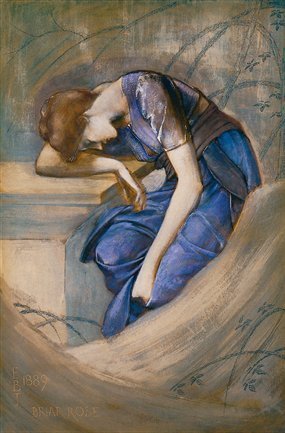
Edward Burne-Jones,
The Briar Rose Series - Study for
‘The Garden Court,’ 1888-1889.
Bodycolour and chalk on paper laid onto
prepared board, 89 x 59 cm.
Birmingham Museums & Art Gallery, Birmingham.
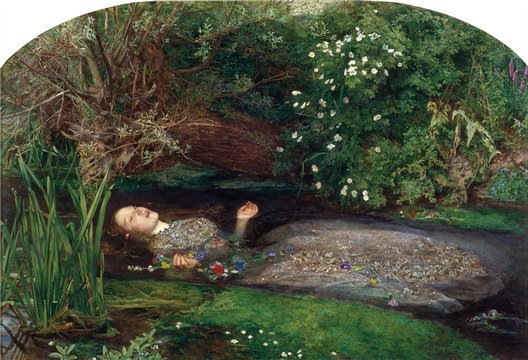
John Everett Millais,
Ophelia, 1851-1852.
Oil on canvas, 76.2 x 111.8 cm.
Tate Gallery, London.
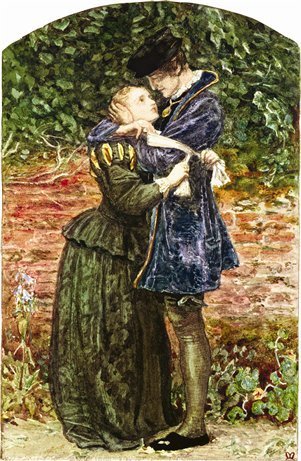
John Everett Millais,
The Huguenot, c. 1852.
Watercolour and pen and ink on paper,